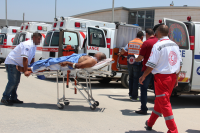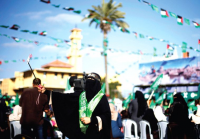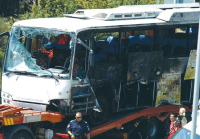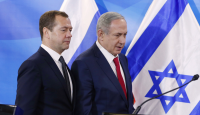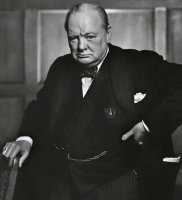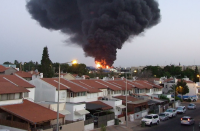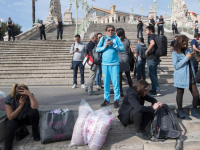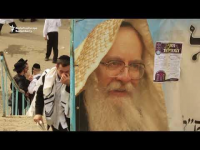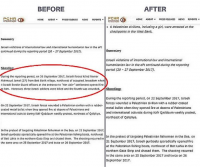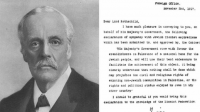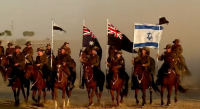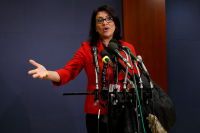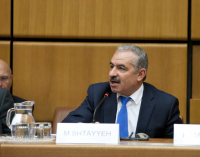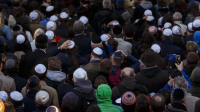Twelve days after the al Durah footage hit Arab TV screens, a mob of Palestinians shouting “Revenge for the blood of Muhammad al Durah” savagely lynched two Israeli reservists whom the PA Police had taken into custody, and dragged their body parts through the streets of Ramallah. The viciousness of the behavior stunned not only Israelis, but even the most sympathetic journalists then in Ramallah. Israel’s responses, all aimed at property not people, included bombing the transmitters of “Voice of Palestine” which, they claimed, were inciting the violence with their broadcasts.
On October 24, 2000, William Orme covered the issue with a piece entitled “A Parallel Mideast Battle: Is It News or Incitement?” in which he explored Israeli claims that Palestinian incitement was a major source of this sudden and terrible violence that swept away the “Peace process” that the NYT editorial board had so enthusiastically supported.
He quoted a Palestinian spokesman who dismissed these claims out of hand, and presented the Israeli objections as overblown and against free speech:
”This [radio station which the Israelis had bombed] was the voice of the intifada, and people could express their feelings without censorship,” said Ibrahim Milhem, the host of ”Good Morning Palestine,” a popular call-in talk show. ”The only way Israel could stop it was to bomb it… Every word the Israelis hear on the Voice of Palestine they think is incitement… But what they are hearing is Palestinians demanding our rights.”
Then turning to Israeli claims that they bombed the station in the same way that NATO had bombed stations in Yugoslavia where the official media incited violence, he presented the Israeli case:
Israelis cite as one egregious example a televised sermon that defended the killing of the two soldiers [at Ramallah on October 12, 2000]. “Whether Likud or Labor, Jews are Jews,” proclaimed Sheik Ahmad Abu Halabaya in a live broadcast from a Gaza City mosque the day after the killings.
“Huh?” the reader might reasonably exclaim. “This is what the Israelis are kvetching about? That’s the best they can do? Aren’t there Israelis who say, ‘Fatah, Hamas, what’s the difference?’”
To the uninformed reader, this passage seems to support Mihem and more: “any word the Israelis hear they think is incitement.”
But this is the full text of his speech:
“The Jews are the Jews. Whether Labor or Likud the Jews are Jews. They do not have any moderates or any advocates of peace. They are all liars. They must be butchered and must be killed… The Jews are like a spring as long as you step on it with your foot it doesn’t move. But if you lift your foot from the spring, it hurts you and punishes you… It is forbidden to have mercy in your hearts for the Jews in any place and in any land. Make war on them any place that you find yourself. Any place that you meet them, kill them.” PA TV, October 13, 2000
What has happened here? Did Orme think that these genocidal comments were unimportant? Or did he think that it would be better if his audience — Americans “back home” — didn’t know about such matters? Is this his judgment of what’s the “news that’s fit to print”? And if so, why such a bizarre judgment? Certainly as an historian, if a student offered me a paper with such a quotation, I’d give him back the draft and say, “what’s wrong with you?”
So what’s wrong with Orme, who is no freshman writing his first paper, but a professional journalist who had been writing for the NYT since 1985? There are many possible, overlapping explanations, including the problems this would pose for the “framing narrative” of the conflict to which the press — NYT included — subscribed quite profoundly.
But for now, I’d like to focus on one, perhaps the most insidious because of the heavy pressure not to mention it: intimidation.
Publishing that sermon’s revolting message would have put the Palestinians in a bad light; it would have alienated Westerners from their cause at a time when a great deal — and the most vocal — of Western public opinion supported them enthusiasticly. How would the Palestinians respond?
Well, the events of the previous two weeks had demonstrated quite effectively what news media dynamics were at work. The Palestinians, aware that if the footage got out, it would make them look bad, did not hesitate to confiscate, even batter any journalist who had the nerve to consider this legitimate news.
They were just a few feet in front of me and I could see everything. Instinctively, I reached for my camera. I was composing the picture when I was punched in the face by a Palestinian. Another Palestinian pointed right at me shouting “no picture, no picture!”, while another guy hit me in the face and said “give me your film!”.
I tried to get the film out but they were all grabbing me and one guy just pulled the camera off me and smashed it to the floor. I knew I had lost the chance to take the photograph that would have made me famous and I had lost my favourite lens that I’d used all over the world, but I didn’t care. I was scared for my life.
One crew of journalists, from a private Italian TV station defied the Palestinians and smuggled out the footage which they gave to the Israelis. They were forced to flee Israel and go into deep hiding in order to escape the wrath (and long reach) of the Palestinians. And lest one think they might have panicked, the behavior of Riccardo Cristiani, the head of Italy’s public TV station sheds a bright light under this particular rock. Afraid that his own journalists might be attacked in a case of mistaken identity, he wrote a letter of clarification to Yassar Arafat that must rank high on the list of revelatory sycophancy in the history of a free media:
Special Clarification by the Italian Representative of RAI, the Official Italian Television Station
My dear friends in Palestine. We congratulate you and think that it is our duty to put you in the picture (of the events) of what happened on October 12 in Ramallah. One of the private Italian television stations which competes with us (and not the official Italian television station RAI) filmed the events; that station filmed the events. Afterwards Israeli Television broadcast the pictures, as taken from one of the Italian stations, and thus the public impression was created as if we (RAI) took these pictures.
We emphasize to all of you that the events did not happen this way, because we always respect (will continue to respect) the journalistic procedures with the Palestinian Authority for (journalistic) work in Palestine and we are credible in our precise work.
We thank you for your trust, and you can be sure that this is not our way of acting. We do not (will not) do such a thing.
Please accept our dear blessings.
Signed,
Ricardo Christiano
Representative of RAI in the Palestinian Authority
(the official Italian station)
As a historian, this letter, with its cloying tone (”dear friends… congratulate you… dear blessings”), it’s ludicrous contradictions (”credible in our precise work”), and it’s euphemistic capitulation (”always respect journalistic procedures), has the sure ring of the obsequious world of pre-modern courts, where bowing and scraping for favor are the only way up. (So much for “speaking truth to power.”)
Nor were the Palestinians ashamed of their behavior. On the contrary, they took the triumphant gesture of one of the lynchers — bloody hands aloft at the window —
and turned it into the a kindergarten graduation ceremony!
They’re not ashamed of this within their own culture; for them it was a moment of triumph. What they don’t want, is for us westerners to know about it.
Which gives us an insight into the just what are these journalistic procedures that govern work in Palestinian-controlled territory?
- Above all, do not report things that make the Palestinians look bad. No shots, for example, of Palestinians celebrating 9-11. (Pierre Rehov reports that after shooting footage in the PA, reporters are expected to show it to their “handlers” who confiscate anything “inappropriate.” Had he not slipped out in the middle of the night, he could not have made The road to Jenin.
- And shoot things that make them look good, even if they’re faked. Many shots of Yassar Arafat faking giving blood in response to 9-11.
- And do report things that make the Israelis look bad, like Pallywood footage. Asked by an Israeli journalist why he had said that the fire came from the Israeli position when he had no evidence for it, Charles Enderlin responded, “If I didn’t say that the father and son were victims of fire coming from the Israeli position, people in Gaza would say, ‘How is it that Enderlin doesn’t say that this is the IDF?’”
How is that an answer? Why would that question, asked in Gaza, override journalistic caution (and ethics) in so volatile a report?
The only answer is that in the daily negotiation between the journalist’s loyalty to his sources and loyalty to his audience, Enderlin here betrayed the latter for the sake of pleasing the former. And the ease with which he answered, apparently considering that answer adequate, suggests that this is not a one-time affair. On the contrary, as Cristiano’s letter makes it clear, this is the normative practice, the “the journalistic procedures with the Palestinian Authority for (journalistic) work in Palestine.” So what they say in Gaza has a critical say in what we hear in the West.
All of this is a preliminary discussion meant to help the reader understand what just happened last week, when Steven Erlanger finally wrote his long-awaited article on the incitement to hatred in the Palestinian Authority. In the three years that Erlanger lived in Jerusalem as the NYT correspondent, he never dealt with this critical dimension of the conflict — the preaching of genocidal hatred and the glorification of violence in every aspect of Palestinian culture: mosques, schools, newspapers, TV, radio, even sport’s clubs. Even when he wrote a long piece on the “Children of the Intifada: The Lost Generation” — victims of a almost decade-long Intifada that had destroyed their childhoods, he somehow couldn’t find room for a discussion of the poisonous teachings these youth got in their schools.
Challenged by Laurie Lowenthall on her radio show, he responded (rather dubiously) that “well, that’s an entirely different article.”
So now, more than a year later, Erlanger has delivered, with details on children’s programs and all.
Of course, like a good PCPer, it’s all about Hamas incitement. You’d never know that the same stuff appears daily in the “moderate” Fatah-run PA media. On the contrary, Erlanger insists:
Such incitement against Israel and Jews was supposed to be banned under the 1993 Oslo accords and the 2003 “road map” peace plan. While the Palestinian Authority under Fatah has made significant, if imperfect efforts to end incitement, Hamas, no party to those agreements, feels no such restraint.
CAMERA has documented the fallacy extensively. But at least Erlanger is still “okay” with Fatah. He may not be going back to Gaza (where Enderlin still wants to be able to go and receive a warm welcome), but he can still go back to Ramallah.
But there’s something even more interesting about this half-measure of restitution, run three years too late. Despite the Gaza by-line, Erlanger wrote the piece after leaving the Middle East, from the (relative) safety of Paris:
Interestingly, Erlanger wrapped up his tenure in Jerusalem last month and left for Paris. In his nearly four years as Jerusalem bureau chief, he gave scant attention to the key issue of Palestinian hate indoctrination against Israel and Jews. In fact, not even when he covered the “lost generation of Palestine: its most radical, most accepting of violence and most despairing” on March 12, 2007, did he discuss incitement as a factor in their radicalization. (In the 3,400-word feature, he devoted only one sentence to indoctrination, presenting it as an Israeli “claim.”) Thus the obvious question: why now? Why did the Jerusalem bureau chief of the New York Times wait until he was no longer in the region to address this deep-rooted problem in Palestinian society? Did he not feel safe to report on incitement while he was working in the West Bank and Gaza Strip?
Note that Erlanger has loudly announced that he was never intimidated, just like Enderlin does. That’s one of the most important contributors to the MSM’s Augean Stables — to save face, they can’t admit that the stuff they give their audience is the product of intimidation. And to save face to themselves, they tell themselves all sorts of stories about how they are just “speaking truth to power” (in this case Israeli might), as a way to remain in denial about why their coverage avoids offending the Palestinians as much as possible. All the news you don’t get.


